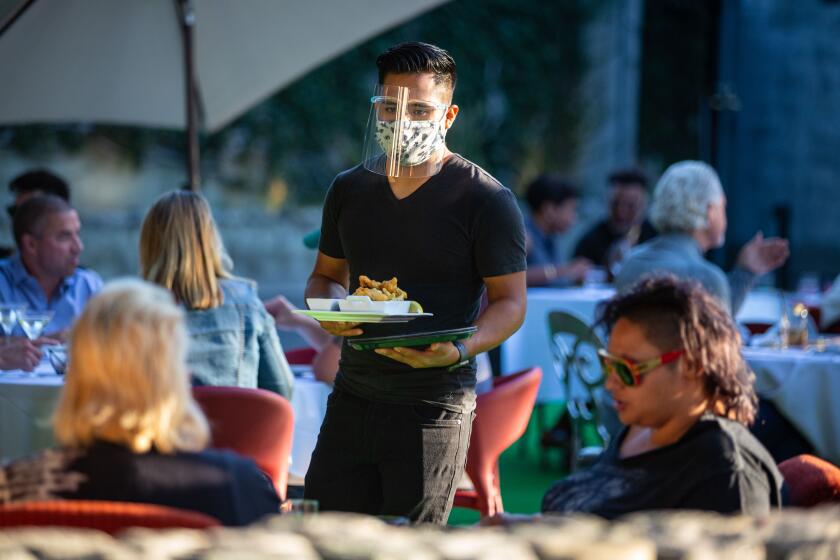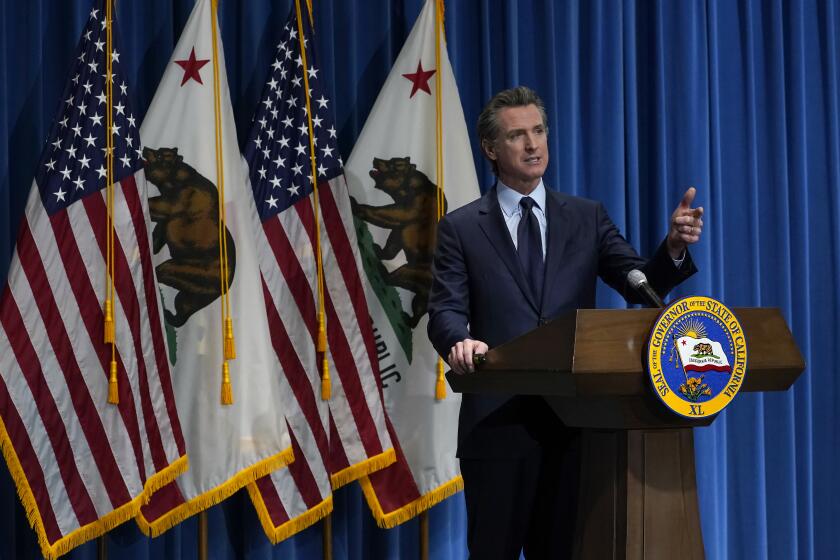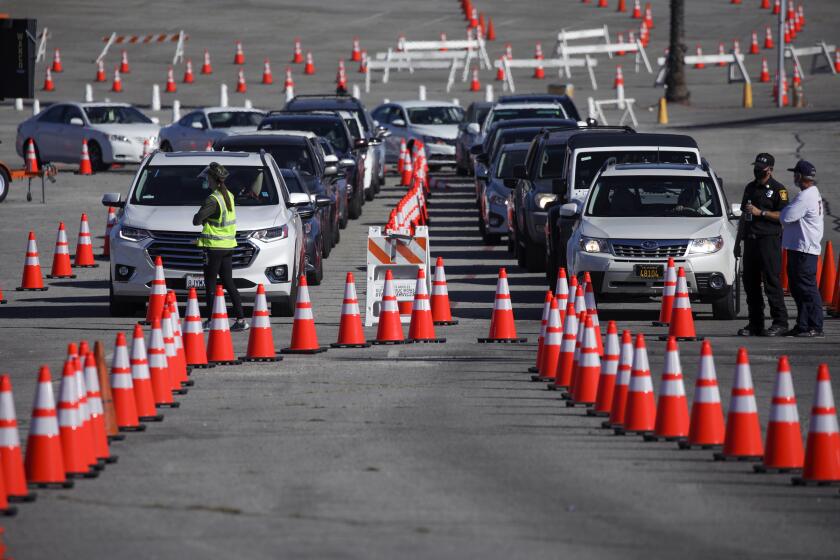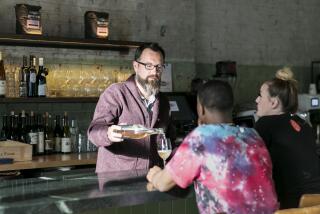L.A. County to resume outdoor dining after COVID stay-at-home order is canceled
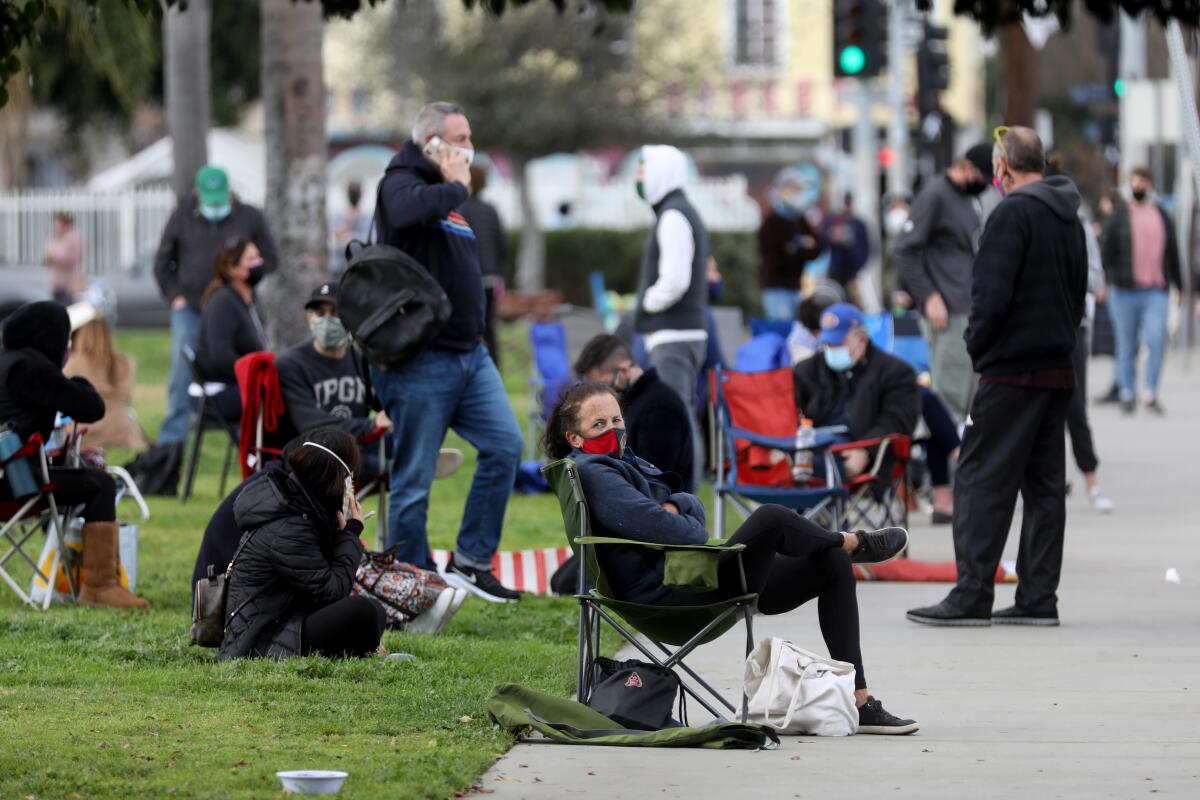
- Share via
Following Gov. Gavin Newsom’s announcement that the state is rescinding its coronavirus stay-at-home order, officials in Los Angeles County said they plan to take advantage of the relaxed restrictions — allowing for the immediate reopening of personal care services and outdoor dining at restaurants later this week.
The news, though positive, came with a repeated caveat: The county is not out of the woods yet, and unless residents and businesses remain vigilant and take steps to protect themselves and those around them, the progress can easily be erased.
“We’re anxious, as is everyone, to move forward,” county Public Health Director Barbara Ferrer said during a briefing Monday.
But, she stressed, “this all depends on all of us” and, if the county’s coronavirus situation starts deteriorating again, “we’ll be in the horrible position of once again needing to backtrack.”
Los Angeles County will allow outdoor dining and ease some other restrictions on businesses, including salons.
Some restrictions are being relaxed immediately. Personal care services, such as hair and nail salons, can open for indoor operations at 25% capacity; tourism and individual travel is permitted at hotels and motels; and outdoor private gatherings of up to three households and a total of 15 people are now allowed.
Ferrer said other measures — including the prohibition on outdoor dining and rules that halted operations of nonessential businesses between 10 p.m. and 5 a.m. — will be lifted in a new health order that’s scheduled to be issued Friday.
“This is not the time for people to think we can get back to our normal business and our normal ways of interacting with each other,” she said. “If we’re not careful, our metrics that are headed in the right direction will quickly change. So, please, do your part to allow us to move forward with careful reopenings.”
A spokesman for L.A. Mayor Eric Garcetti didn’t immediately respond to a request for comment about the county’s reopening plans.
Garcetti could opt to keep outdoor dining and other services in Los Angeles shut down, as the city is allowed to enact tougher restrictions than the county.
The mayor supported the county’s original decision to shutter outdoor dining, a move that made him a target of local restaurant owners.
The action by state officials means restaurants and gyms could soon reopen outdoor services. Counties will make the final call, however.
L.A. County health officials suspended outdoor dining in late November, prompting immediate outcry from pandemic-battered restaurateurs and pushback from residents and some politicians. Legal action since then has aimed to overturn the order.
Shortly after the county’s ban went into effect, the state handed down the regional stay-at-home order, which widened the outdoor dining prohibition and imposed a host of new restrictions across all of Southern California.
With that order now lifted, L.A. County Supervisor Hilda Solis said Monday the county would “essentially align with the state” on permitted activities.
“Please don’t take this news to mean that you can return to life as normal,” she said. “Masks, physical distancing and limiting activities are still key to getting out of this pandemic until we can get everyone vaccinated.”
The dispute over outdoor dining has been heated. Public health officials have regularly defended the ban, saying that activities involving people spending extended periods of time in close proximity with those outside their homes while not wearing a mask heightens the risk of coronavirus transmission.
Some proprietors and politicians, however, pushed back and lobbied to overturn the rule.
“We should align ourselves with the state as much as possible, which means, among other things, reopening outdoor dining with commonsense health protocols in place as soon as possible,” L.A. County Supervisor Janice Hahn said in a statement ahead of Monday’s briefing. “The restaurant industry was devastated by this lengthy shutdown, and I know this would be welcome news to them.”
Supervisor Kathryn Barger also said she supported reopening outdoor dining, personal care services and other industries that were previously closed.
“A data-driven and pragmatic policy approach is essential to protecting public health, while balancing the devastating social, emotional and economic impacts of this virus,” she said.
Since the outdoor dining ban was first announced, some have demanded to see the data justifying the move and questioned whether its benefits justified the economic devastation.
“People have lost their jobs, and if restaurants and bars continue to close, they will lose them permanently,” the Independent Hospitality Coalition said in a statement Monday.
The coalition, the statement continued, “wants to make sure we don’t just throw open the doors again without clear guidelines to help stop the spread of COVID-19. However, we believe that outdoor dining can safely reopen.”
Though the county now plans to lift the restriction, Ferrer said the underlying message has not changed: People need to wear face coverings when around others and must avoid crowding together indoors.
It’s the latest in a string of enforcement efforts officials have lodged against Restauration and its owner in recent weeks.
The state’s decision to lift the regional stay-at-home order means all areas of the Southland can now resume outdoor dining, if they so choose.
For restaurant owners in Orange County, the news of reopened outdoor dining was widely celebrated Monday — even among those who opted not to close.
“This is a huge step forward, and it’s a big relief for everyone in this industry,” said JC Clow, the founder and managing partner of the Winery Restaurant Group, which has two locations in Orange County and one in San Diego County.
Orange County has been a regular source of opposition to state coronavirus-related directives throughout the pandemic. Some restaurants have defied the order to shutter outdoor dining entirely, while others continued to serve patrons indoors.
Clow closed outdoor dining at his three locations for about a week when California issued the expanded stay-at-home order in December. It was a huge blow to staffers who depended on the restaurants for a steady paycheck and income from gratuities. He started getting daily phone calls from staff members who were pleading for help, he said, with some on the brink of homelessness.
“As those personal stories started coming in, we couldn’t just sit on our hands and do nothing,” he said. “A lot of these people have been with us since Day One, and when you hear those heartfelt cries for help, we just couldn’t turn the other cheek. We had to do what we could while still being safe, so we reopened outdoor dining.”
California’s ability to multitask is being tested as health officials scramble to find staff for vaccination sites while maintaining testing and contact tracing.
Clow spent thousands on personal protective equipment, medical-grade partitions and other safety equipment. Still, he worried daily that a visit from the California Department of Alcoholic Beverage Control would strip him of his liquor license.
“We sat on pins and needles, and we just prayed every day we didn’t see any of those field officers,” he said. “To lose our liquor license for two weeks or more would have put any of us in a really precarious position.”
Orange County Supervisor Don Wagner, a frequent vocal critic of the state’s pandemic response and Gov. Gavin Newsom, said rescinding the stay-at-home order was “a step in the right direction, but I’ve also learned during the course of COVID that this governor is very erratic. Who knows what will get him to change his mind again?”
“It’s a long time coming,” Wagner added Monday. “It was an unnecessary step when he shut us down. It’s a necessary step for him to open us up. Let’s just not pretend there’s a lot of science that he’s revealed behind his decision.”
Newsom announced the criteria for implementing the regional stay-at-home orders on Dec. 3, saying the additional restrictions were necessary to reduce the strain on hospitals as coronavirus cases skyrocketed.
Although data show that hospital systems in Southern California remain strained, state officials said they projected those areas would exceed 15% available intensive care unit beds four weeks from now — meaning they meet the criteria to exit the order.
Monday’s announcement is one of the clearest signs yet of the growing optimism that California has finally begun to beat back the coronavirus surge that’s ravaged the state for months.
“It’s a very good trend, not only for Orange County, but for other counties throughout the state,” Orange County Supervisor Lisa Bartlett said. “It means our positivity rates are finally starting to come down and we’re through the spikes from Christmas and New Year.”
Solis said the decision “reflects the hard work of Angelenos these past months to stay home and save lives.”
“However, we cannot let our guard down again,” she said. “We’ve seen what it means when that happens, when we visit with others in their homes, attend large gatherings and run errands like we did pre-pandemic. That cannot happen again. We must continue to meet the moment and defeat this virus as soon as possible.”
Even without the stay-at-home order, it’s far from business as usual in California. Counties are still subject to restrictions outlined in the state’s four-tiered, color-coded reopening road map, which categorizes areas based on their COVID-19 case and positive test rates.
Virtually the entire state — 54 out of 58 counties — remains in the most restrictive purple tier. In those areas, indoor operations will remain suspended or severely limited at many businesses and other public facilities.
Scientists thought the U.K. variant was more transmissible, but evidence suggests those who have the virus are also more likely to die from it, Dr. Anthony Fauci says.
The state rules serve as a baseline; while local jurisdictions can be stricter, they cannot be more lenient.
Many municipal leaders throughout the Southland have lobbied Sacramento to loosen regulations and give local leaders a greater say in determining how widely to reopen their economies. Some L.A. County cities have even floated the idea of forming their own health departments, which would free them from having to follow the county’s lead.
In Pasadena, one of the two L.A. County cities that already has an independent health agency, officials said businesses and organizations would again follow the restrictions and guidelines outlined in the purple tier.
Pasadena grabbed headlines in late November when officials there opted to keep outdoor dining open even after the county issued its health order to suspend such operations.
Because Pasadena has its own health department, it was allowed to make that call, and city spokeswoman Lisa Derderian said “we couldn’t show data that reflects cases traced back to restaurants.” The city was later forced to close outdoor dining when the state enacted its sweeping stay-at-home order.
However, Derderian said any reopenings were couched in a cold reality: The pandemic is still here, and it’s continuing to have devastating impacts.
“Our cases are lower, but to announce deaths and to announce we’re lifting restrictions is kind of that double-edged sword,” she said. “We understand economic impacts … but we don’t want people to let their guard down now if we lift too many restrictions.”
Times staff writer Dakota Smith contributed to this report.
More to Read
Sign up for Essential California
The most important California stories and recommendations in your inbox every morning.
You may occasionally receive promotional content from the Los Angeles Times.
